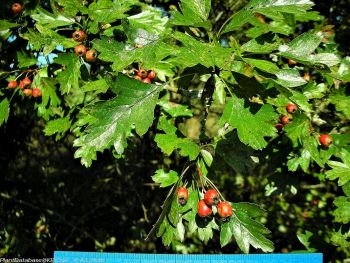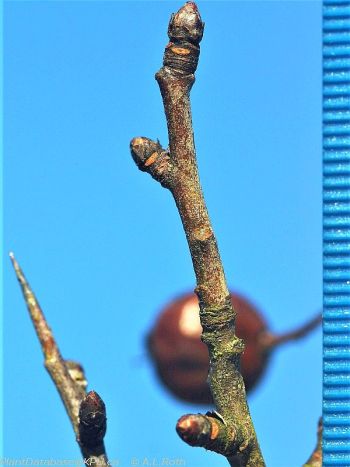Scientific Name:
Crataegus monogyna
Pronunciation:
kruh-TEE-gus mon-oh-JYE-nuh
Common Name:
common hawthorn
Family Name:
Rosaceae
Plant Type:
Shrub - deciduous, Tree - deciduous, Weed (horticultural)
Key ID Features:
Leaves alternate, most blades ovate, 4-7cm long x 2-6cm wide, (3-)5-7 serrate lobes, deeply incised, glossy green, petioles 1.5-2.5cm long; corymbs with flowers 8-15mm wide, 5 white petals, 10 anthers turn pink-red to nearly black, pistil style unbranched, moderately fragrant, May; pomes dark red, oval, about 1cm long, single seed. Winter ID: small tree 5–14m tall, crown dense, thorns 1.5-2.5cm long, persistent fruit.
Habit:
Dense, Upright
Form:
Oval - vertical
Texture:
Medium
Mature Height:
7 - 10m
Mature Spread:
5 - 7m
Growth Rate:
Fast
Origin:
Europe
Hardiness Rating:
Zone 5: (-29 to -23 °C)
Exposure:
Full sun, Part sun/part shade
Soil/Growing Medium:
Well-drained
Landscape Uses:
Attract birds, Hedge row, Spring interest
Additional Info:
Leaf Morphology:
Form:
Simple, Lobed
Arrangement:
Alternate
Texture/Venation:
Soft flexible, Palmate venation
Surfaces:
Glabrous
Colour in Fall:
Yellow
Shapes:
Ovate
Apices:
Obtuse
Bases:
Obtuse
Margins:
Serrate
Bark Morphology:
Plated
Bark or Stem Colour:
Grey, Brown
Leaf Bud Type:
Ovoid, Rounded or globular
Leaf Scar Shape:
Crescent shaped
Organ Modifications:
Stipule (leafy), Thorns
Propagation:
Seed
Maintenance:
Medium
Pest Susceptibility:
Caterpillar or cutworm, Diptera - true flies, Fungal leaf spot, Leafhopper, Rust (Drought tolerant)
Specific Pests:
Course(s):
- not used (on campus)
Location(s):
- (FSC) Far South Campus
- (TFL) Turf Field Lab
- (WDH) Wark-Dumais House





